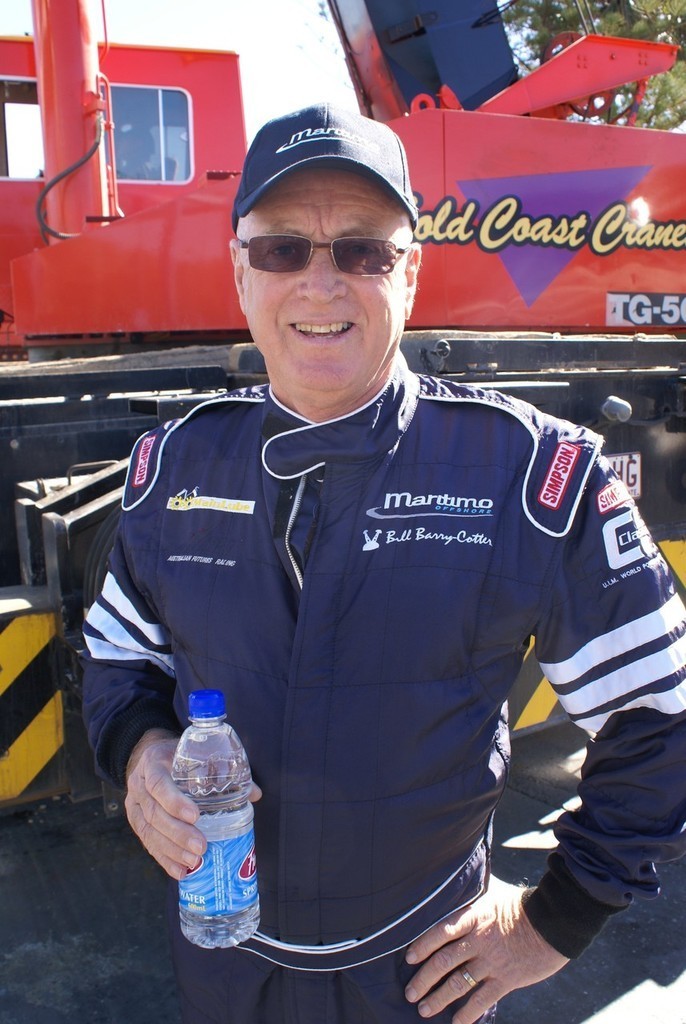Class 1 racing on the threshold of a new era
by Bob Wonders on 26 Jul 2008

Bill Barry-Cotter, award-winning boat manufacturer and seven-times Australian Class 1 offshore champion. Bob Wonders
Class 1 offshore powerboat racing is set to enter a new era which will result in costs to launch a race-ready boat reduced by one million dollars.
The massive technical rule change proposal has already been ratified by the powerful International Offshore Teams Owners Association (IOTOA) and is expected to be ‘rubber stamped’ by the UIM (Union Internationale Motonautique), the sport’s governing body, at its next meeting in August.
It has also won the full support of the World Professional Powerboat Association (WPPA), formerly a break-away group from the UIM, which has now ‘buried the hatchet’ and is again a UIM supporter.
Driving force behind the proposal, the most massive injection of interest in the sport’s history, is none other than Australian marine industry figure, Bill Barry-Cotter.
Barry-Cotter, CEO of award-winning boat manufacturer Maritimo, has won seven Australian Class 1 Offshore championships and is currently campaigning two boats in the class carrying the ‘Maritimo’ and ‘Simrad’ names.
He identified that Class 1was confronted with three major problems; the increasing costs involved campaigning a competitive team, the decreasing parity between teams and the decreasing number of competing teams.
Barry-Cotter’s ‘new era’ calls for identical catamaran-style race boats with a minimum length of 11.5-metres and a maximum of 13.0-metres; they will have a minimum weight of 4100kg.
Engines will be naturally-aspirated, 790hp, 8.0-litre V8 blocks limited to a maximum 7600rpm.
The new boats are to be constructed from E-glass and Balsa Core, with no expensive Carbon Fibre.
Additional cost savings stem from the maximum beam allowed, 3.5-metres; this is the maximum width on Australian and United States roads for a ‘wide load’; therefore expensive tilt trailers will not be required to transport the boats.
Barry-Cotter estimated a cost of $1.4 million was required to bring a race-ready boat to the start line built from Carbon Fibre and Nomex and powered by V12 Lamborghini engines.
The cost to field one of the new 790hp V8 boats has been estimated at $400,000 to $500,000, nearly a massive $1 million less.
Five of the new boats are already under construction at Maritimo’s Coomera plant, with deposits already taken on three by team owners intending to participate in the re-vamped Class 1.
The first boat to run the new 790hp installation is currently undergoing testing on the Gold Coast and will make its race debut at the Australian Offshore Superboat series during the Gold Coast round in October.
It is expected that three of the 790hp boast will be entered, together with five of the former Class 1 boats, resulting in a strong eight-boat field.
Also in October, a demonstration race will be staged for the UIM General Assembly scheduled to meet on the Gold Coast for the first time.
Existing Class 1 boat/engine combinations will still be allowed to compete alongside the new 790hp class under UIM/WPPA rules for a limited period that has yet to be determined.
However, in the event of a boat/engine combination possessing a clear advantage over another competitor, the race commission may penalise that boat with a corresponding weight penalty.
A major factor in the adoption of the 790hp V8 Class 1 is in the simple fact that races will be won by the skills of driver and throttleman, not by the team with the largest chequebook.
Engines can be those manufactured by Mercury Marine (MerCruiser) or other US manufacturers such as Stirling and Eckhart.
Team owners can also build their own engines by working to a specified list of authorised spare parts.
'The 790hp V8 is widely used in the United States in the Supercat Class,' Barry-Cotter said.
'Therefore, using the engine here in Class 1 would attract stronger interest from the US and potentially increase the likelihood of more competitors.
'These engines are carburettored, making it very difficult to gain extra horsepower, therefore racing will be fair and even,' he added.
The naturally-aspirated engine specifications are intricately detailed.
Maximum displacement has been set at 510cu in, minimum at 495cu in.
Engine blocks, valve systems, cylinder heads, intake manifolds, internal components, induction systems and exhaust systems and transmissions have all been specified as
standard requirements.
Barry-Cotter said the 'amazing success' of the New Zealand Offshore Powerboat Series had prompted him to undertake the revision of Australia’s Class 1 rules.
'What the New Zealanders did has made their Superboat’ class less expensive and fairer, and the future for the class looks very bright indeed,' he said.
'In 2005 they had only two boats in the class, but for 2009 they predict at least seven competitors,' he added.
The Kiwi boats are smaller than the Australian Class 1 boats, limited to a maximum 10.66-metre length, a 2.4-metre beam and they can run only 525hp stern drive MerCruiser engines.
A strong support base, national television and 45 teams spread across a number of classes have led to a highly viable series in New Zealand.
'And we can achieve similar here,' Barry-Cotter declared.
Maritimo has already purchased 21 new and second-hand 790hp engines for its own and prospective customer use.
'Offshore powerboat racing is something of a sleeping giant on the Australian sporting scene and I’m confident the adoption of these new rules will awaken the sport to a new generation of fans,' Barry-Cotter added.
If you want to link to this article then please use this URL: www.sail-world.com/46893